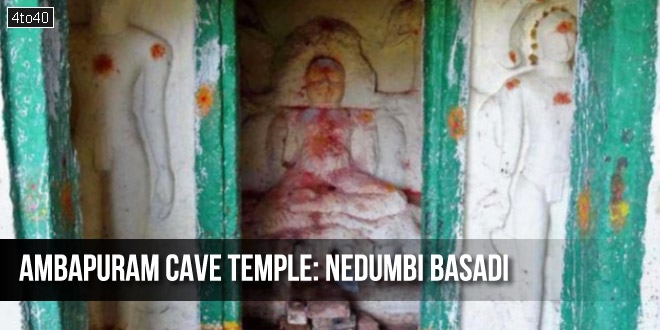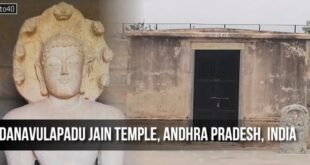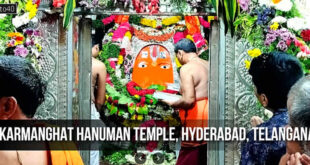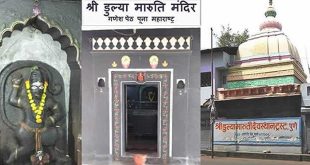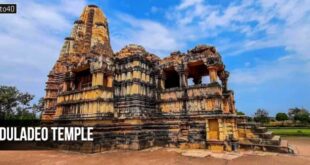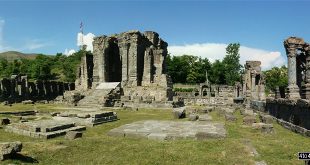Ambapuram cave temple or Nedumbi Basadi is a rock-cut Jain cave temple in Ambapuram village near Vijayawada in the Indian state of Andhra Pradesh.
Ambapuram Cave Temple
| Name: | Ambapuram Cave Temple: Nedumbi Basadi |
| Location: | Ambapuram village near Vijayawada, Andhra Pradesh India |
| Deity: | Mahavira |
| Affiliation: | Jainism |
| Completed In: | 7th century CE |
| Architecture: | Rock-cut architecture |
| Creator: | Eastern Chalukyas |
Jainism became popular in the Vijayawada region during the reign of Eastern Chalukyas or Vengi Chalukyas in the 7th century CE. During the 7th – 8th century CE, a total of five Jain caves were constructed in Ambapuram and Adavinekkalam hills. The village derives from the image of Goddess Ambika inside the Jain cave temple.
The cave temple enshrines three cells — Veranda, antarala and garbhagriha. The verandah has plain walls and ceilings devoid of sculptures. The antharala features images of yaksha on either side of the door and an idol of Parshvanatha having a serpent hood with five heads. The antharala has an image of Goddess Ambika as protector deity and a carving of an unidentified deity. There is an image of chauri (whisk) bearers on each side of Mahavira. The rear wall of the garbhagriha houses an idol of Mahavira, the 24th Tirthankara, in lotus position with the symbol of lion stamped on the pedestal. The cave temple also features a rock-cut miniature Jain stupa. A 3 feet (0.91 m) tall idol of Parshvanatha with 7 hooded serpent in Kayotsarga posture. The idols date back to 7th century during the reign of Kubja Vishnuvardhana (c. 624–641 CE).
In 2019, Cultural Centre of Vijayawada, RCV along with 70 students organised a trek to promote tourism to this cave temple.
The Hindu Newspaper: Ancient Jain temple cries for attention
Source: https://www.thehindu.com/
Vijayawada was earlier called Vijaya Vatika & Bezawada and was known for its cultural harmony. Vijayawada, formerly known as Bezwada, was an important centre of the Vishnukundin rulers in the fifth-sixth centuries. The city was taken by the Early Chalukya (later known as Eastern Chalukya) of Badami and became the headquarters of their eastern domains. The strategic position of the town commanding the coastal trading routes of the Bay of Bengal determined its economic importance through the centuries. It is surrounded by picturesque hills with the river Krishna flowing on the south.
While the period between 1st century B.C. and 4th century A.D. saw Buddhism thriving here attracting a good number of monks from the north and south directions, a gradual decline of Buddhism around 5th century A.D. gave way to Saivism. These were appropriated by the Vaishnavas in the 6th century A.D. which reflects in sculptures of Krishna, Sita and Anjaneyulu on the pillars of caves.
But the advent of the Eastern Chalukyas or Vengi Chalukyas in the 7th century A.D. witnessed a U-turn towards a non-Vedic religion. The Jammi Doddi area, next to Akkanna and Madanna caves at the foot of Indrakeeladri hill, nestled a Jain monastery called Nedumbi Basadi which received patronage of Ayyana Mahadevi, the queen of Kubjavishnu Varadana and founder of the Eastern Chalukyan kingdom. Jain establishments are also found at Kolanukonda, Kanur and Guntupalli villages located on Vijayawada suburbs.
“The hills on the north-east corner of the city, locally called Ambapuram and Adavi Nekkalam hills were repositories of Jain caves of the 7th-8th centuries A.D. They are wrongly called Bairlingeswara Swamy temple because of the presence of a rock-cut miniature Jain stupa which the locals still believe to be a Siva Linga. The caves are affiliated to the Jaina pantheon represented by the Tirthankara and Ambika sculptures,” says archaeology expert E. Sivanagi Reddy.
These caves, lying in ruins, can be approached either from the Vijayawada-Nunna or milk factory-Adavi Nekkalam route. They have an open scooped out platform that leads to three cells one after the other namely—verandah preceded by an antharala (ante-chamber) and garbhalaya (sanctum sanctorum)
The verandah has plain walls and ceiling devoid of sculptural representations. The arthamandapa is decorated with figures of two male attendants carved on either side of the doorway of the garbhalaya. A nude image of Parsvanatha, the 23th Tirthankara of the Jain pantheon is canopied by a five-hooded Nagadevatha. The identity of another image carved on the wall on the eastern side is not clear.
The principal attraction is carved on the rear side wall of the rock-cut Garbhalaya—the image of Vardhamana Mahaveera, the 24th and the last Tirthankara attested by lion symbols seen on the pedestal. Seated in padmasana, the image contemplates meditational absorption. “The female attendant on the arthamandapam walls is supposed to be Ambica, the sasana devata, on whose name the village is called Ambapuram that perpetuates the Jaina faith to future generations,” says Prof. Nagireddy.
There is no proper pathway to the caves from Ambapuram. The least the authorities can do is to create a path and enable people to visit this ancient Jaina monument.
The cave temple enshrines three cells – Veranda, antarala and garbhagriha. The verandah has plain walls and ceilings devoid of sculptures. The antharala features images of yaksha on either side of the door and an idol of Parshvanatha having a serpent hood with five heads. The antharala has an image of Goddess Ambika as protector deity and a carving of an unidentified deity. There is an image of chauri (whisk) bearers on each side of Mahavira. The rear wall of the garbhagriha houses an idol of Mahavira, the 24th Tirthankara, in lotus position with the symbol of lion stamped on the pedestal. The cave temple also features a rock-cut miniature Jain stupa. A 3 feet tall idol of Parshvanatha with 7 hooded serpent in Kayotsarga posture. The idols date back to 7th century during the reign of Kubja Vishnuvardhana (624–641 CE).
 Kids Portal For Parents India Kids Network
Kids Portal For Parents India Kids Network
